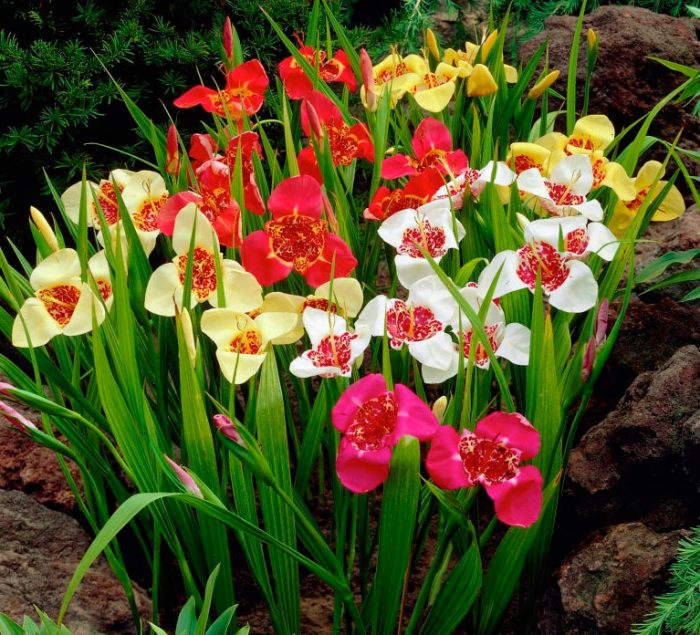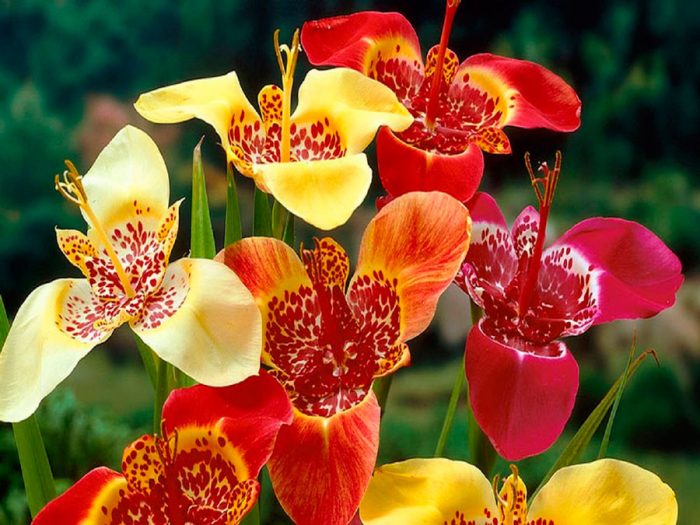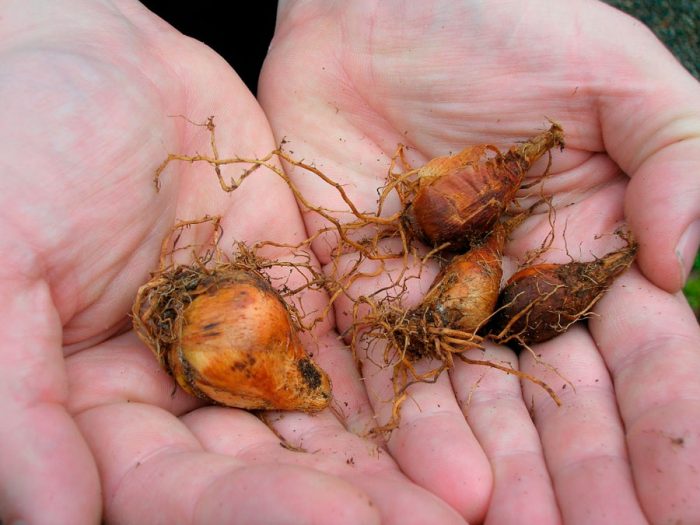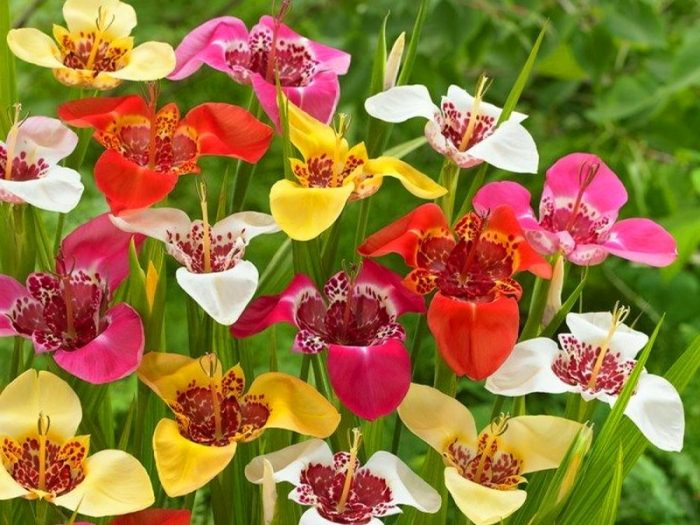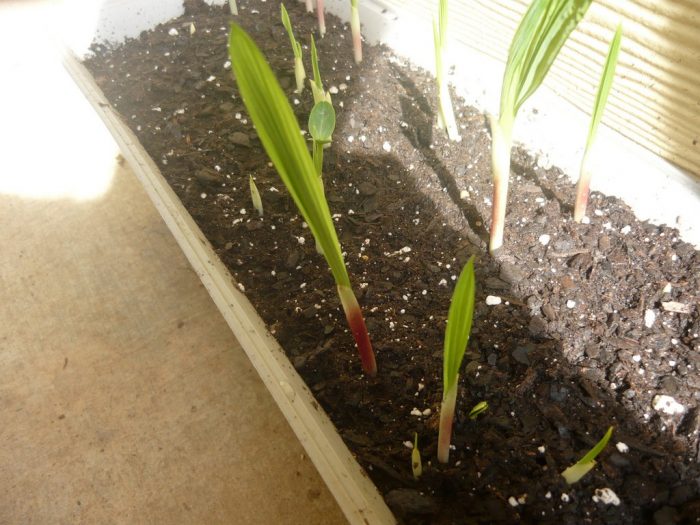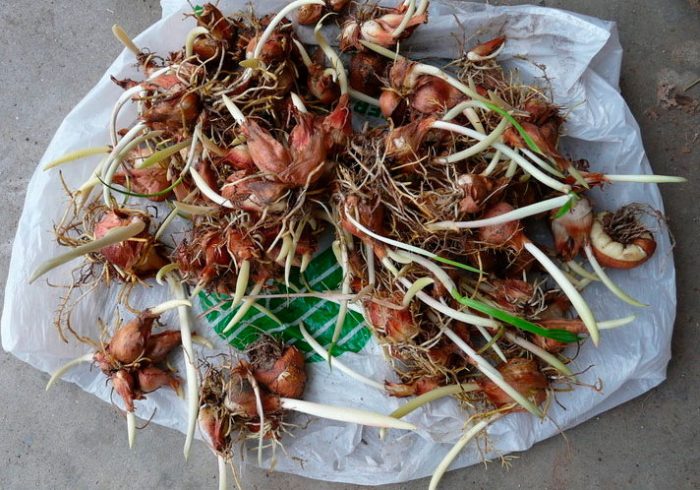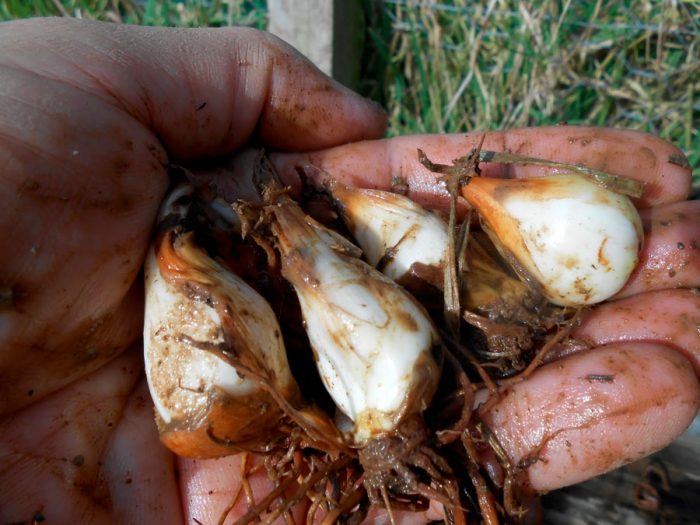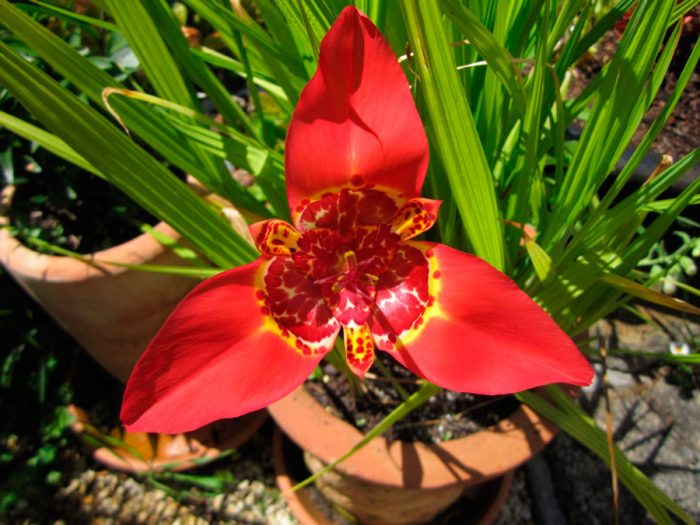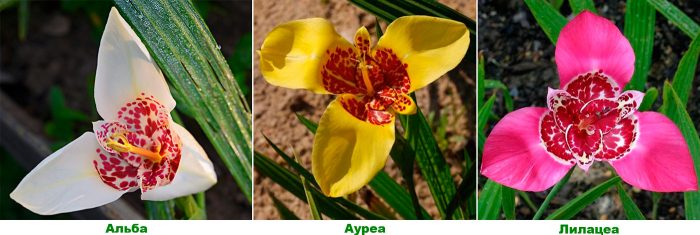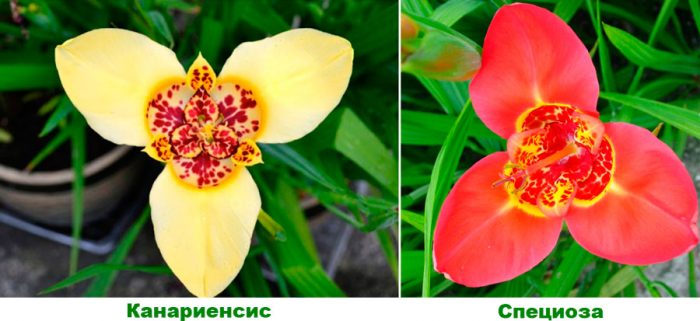Bulbous herbaceous perennial plant Tigridia (Tigridia) is a member of the family Iris (Iris). According to various sources, this genus unites 20–55 species. The range of this culture extends from Mexico in the north to Peru and Chile in the south. The name of this flower is derived from the Latin word tigris (in the genitive case - tigridis), which means "tiger", most likely, this is due to the variegated color of the perianth. Previously, the Aztecs lived on the territory of Mexico, they grew these flowers, because they have medicinal properties. In Europe, tigridia has been cultivated since the 16th century, but it has never been very popular with gardeners, most likely, this is due to the fact that such a plant blooms only in the first half of the day, and the life of a flower is only 8 hours.
Content
Features of tigridia
The height of the tigridia bush can vary from 0.3 to 0.7 m. This perennial bulbous plant can have branched or simple shoots. Evenly folded greenish leaf plates have a xiphoid shape. Single flowers are located at the tops of the arrows, and they can also be collected in 2 or 3 pieces. The flowers have a bizarre shape similar to an exotic butterfly. The fruit is a capsule with squeezed, angular seeds inside.
Planting tigridia in open ground
What time to plant
Since tigridia bulbs react extremely negatively to frosts, they should be planted in open soil only after warm weather has established, as a rule, this time falls on the last weeks of spring or the first - summer. Choose a sunny open area for planting. It is possible to grow this culture in partial shade, but in this case the peduncles will become weak and thin, and therefore they will need a garter to the support. Also, the site must be protected from drafts and sudden gusts of wind, since they are capable of injuring the thin and weak shoots of this flower. A suitable substrate should be loose, light, moderately moist, well drained and non-acidic. To fix excessively dense soil, you can add sawdust or sand to it.
Landing rules
Immediately before planting, the planting material must be immersed in the Maxim solution for a couple of hours (for 1 liter of water, 2 milligrams).Bulbs treated in this way will be protected from fusarium disease, white and gray rot and other diseases. To what depth the bulbs are embedded directly depends on their size. For example, the smallest bulbs should be planted to a depth of about 50 mm, and the largest ones are buried in the soil by 100 mm. A distance of at least 15 centimeters should be maintained between the bulbs in a row, while the distance between the rows should be about 20 centimeters. The first shoots can be seen only after 30–40 days, the grown bushes will bloom in August, but as a rule, they do not have time to bloom before frost, which is extremely bad for replacing bulbs. In this regard, experienced gardeners advise, before planting corms in open soil, to grow them indoors. To do this, in the last days of March, they are placed for distillation. More about this will be discussed in the section on transplanting this plant.
Caring for tigridia in the garden
Growing tigridia in your garden is pretty easy. She needs to ensure timely watering, weeding, feeding and loosening the soil surface between the bushes. Experienced gardeners advise to cover the surface of the site with a layer of mulch, this will not only preserve the structure of the soil, but also reduce the number of watering, weeding and loosening. It will also be necessary to remove flowers that have begun to fade in time, and, if necessary, tie bushes to pegs or twigs.
How to water and feed
When grown in a garden, this plant needs systematic watering. During prolonged drought, the bushes should be watered every day, while using such a volume of water so that the earth can get wet to the depth of the corms. Also, with prolonged drought, the aerial part of the bushes will need to be moistened from a spray bottle with lukewarm water in the evening.
If, in preparation for planting, all the necessary fertilizers were introduced into the ground, then it will be possible to forget about feeding tigridia until the end of the season. If the soil is poor or depleted, then the bushes will need to be fed only a couple of times per season, and a solution of complex fertilizer is used for this (3 grams per 1 liter of water). Top dressing should be applied 4 weeks after the appearance of foliage and during budding.
Transfer
In order for the plants to bloom early, at the beginning of the spring period, the bulbs need to be grown indoors. They should be planted in the last days of March in a pot of light soil. 3 or 4 corms are planted in 1 pot at once, while they must be buried in the substrate by at least 30 mm. The bulbs will need to be watered moderately in the first weeks. After the corms begin to sprout, the abundance of watering must be increased, it should be noted that the substrate should get wet to the depth at which the roots of the corms are. It is best to choose pots with wide openings for drainage for planting corms, and the plate stand should be quite high so that the tigridia can be used for bottom watering. With such watering, the risk of developing fungal diseases is relatively lower. After the arrows appear, the containers with tubers must be transferred to a well-lit, warm windowsill. Remember that drafts are contraindicated for these plants. These corms are planted in open soil in the first days of June.
The depth of the planting pit for the transplanted plant should be from 0.5 to 0.6 m.At the bottom of the pit, a drainage layer should be made of horse manure or broken brick, while its thickness should be from 0.2 to 0.25 m. it should be laid with a layer of loose soil of the same thickness as the previous one. Then it is necessary to place a sprouted corm on it, after which the hole is covered with nutritious soil. Transplanted plants need abundant watering.
Reproduction of tigridia
In the event that the bushes begin to bloom from mid to late July, then the seeds will be able to ripen before frost. Seeds are harvested before frost begins. Their sowing is carried out in the winter, while pre-sowing preparation is not needed for the seeds. The containers are removed in a well-lit, warm (from 20 to 25 degrees) place. When diving seedlings, you need to be very careful to avoid injury to their roots. After the seedlings develop a pair of true leaf plates, they should be cut into individual pots, while they are taken along with a lump of earth. From the moment of sowing to the beginning of flowering, it takes about 6-7 months.
Also, vegetative methods can be used to propagate this culture. During 1 season, about five replacement children grow in one adult corm. They should be separated from the parent bulb before planting, while the places of breaks and cuts should be sprinkled with coal powder, after which the children can be planted in the soil.
Diseases and pests
Quite often, gardeners are unable to preserve tigridia planting material until spring, because most of it rots. As a rule, rot appears on those bulbs that are poorly ripe. That is why it is extremely important, before starting the preparation of corms, to make sure that they are well ripe. Also, for the purpose of prevention, it is imperative to poison the corms before storing them in any fungicidal solution, for example: Maxim, Benlate or Fundazole.
A plant grown outdoors can be affected by scab or rust. To prevent this, it is recommended to spray the foliage with herbal infusions or fungicide solutions.
If the plant is affected by the mosaic, then it is no longer possible to cure it, since viral diseases are currently considered incurable. In this regard, it is extremely important to provide the plant with proper care and conditions suitable for growth so that it is strong and less sore.
Bears, slugs, cabbage scoops and thrips can harm tigridia. To exterminate thrips, as well as the scoop, along with their caterpillars, the foliage of the bushes must be sprayed with a solution of any insecticide. Slugs are collected by hand in order to facilitate their work, pieces of slate or boards are laid out on the site, under which most of the gastropods slide down during hot times of the day. Remove them from under the bait and destroy. And it is necessary to pour the soap solution into the discovered moves of the bear. If the bear tries to escape by getting out, it should be caught and destroyed.
Tigridia in winter
Storage preparation
Since tigridia is a heat-loving plant, it is possible to leave it for the winter in the open ground only in the warmest southern regions. Therefore, with the onset of autumn time, most gardeners remove the corms from the soil and store them until spring, while choosing a cool enough place, but the temperature there should not drop below 0 degrees. However, digging tigridia corms and storing them is not so simple. In order for the planting material to be well preserved until spring, it must be fully ripe, and for this it is necessary to know exactly when to remove the bulbs from the soil in the autumn. This procedure is performed only after all the leaf plates on the bush wither. If there is a threat of frost, but the foliage is still green, it is recommended to dig the bushes together with a lump of earth, which must be large enough, then it is transferred to a cool and well-lit room. Only after the leaf plates turn yellow and wither, it will be possible to start collecting planting material for storage. The preparation of corms for storage includes their cleaning, rinsing, as well as etching in a solution of the Maxim preparation and thorough drying.Separation of children from parent bulbs should be done in the spring before planting, but not in the fall.
Storage rules
Corms should be placed in a container filled with dry sand or peat. They are stored for storage in a cool (3-10 degrees) room with normal air humidity. Also, the bulbs, if desired, can be folded into paper bags, which are removed on the refrigerator shelf intended for vegetables, where they will be stored until spring. During the winter, do not forget about the bulbs; a systematic check should be made, during which all damaged and rotten bulbs must be rejected.
Types and varieties of tigridia
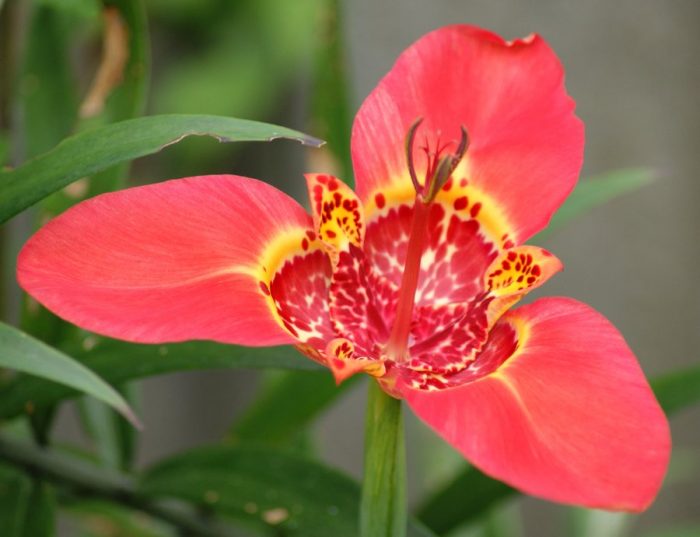
Gardeners cultivate only 1 type of this culture - peacock tigrid (Tigridia pavonia). This species is native to Mexico and Guatemala. The height of the bush can vary from 0.25 to 0.7 m. On the surface of the corms, which have an irregular shape, there are membranous scales. The bulbs are 60 mm long and about 40 mm in diameter. At the end of the growing season, there is a complete depletion of the old corms, however, children grow up in it, which form nests. In the parent corm, the number of babies and scales on the surface is almost the same. 3-5 peduncles will grow from one bulb, and about 5 flowers are formed on each of them. Greenish wide leaf plates folded along the length have a xiphoid shape. The flowers, up to 10-15 centimeters across, consist of 6 lobes that open alternately. In the perianth, the outer lobes are colored orange-purple or deep red, and the inner ones are not as large as the outer ones, they have an orange-yellow spotted color, like the throat. Tigridia blooms in July – August, with the life span of each flower being 8–10 hours. In general, the flowering period is about 2–3.5 weeks. Garden forms:
- Alba... The flowers are white, and there are red spots on their surface.
- Aurea... There are carmine spots on the surface of dark yellow flowers.
- Carminea... The flowers are orange, covered with yellow spots.
- Lilacea... The red-lilac flowers have carmine specks.
- Rosalind... The color of the flowers is pale pink.
- Canaryensis... The yellowish flowers have a rich red center.
- Speciosa... The color of the flowers is scarlet-red, and they have yellow-golden spots on them.
The variety mixture "Tigridia Ferraria mixed" is quite popular: the height of the bush is about 0.6 m, the leaf plates have a xiphoid shape, the flowers reach 15 centimeters across, their outer petals are of a single color (lilac-pink, white, red, orange or yellow) , three inner petals have spectacular specks. Specialists engaged in breeding use in their work Mexican tigridia with yellow flowers, tubular tigridia with pinkish flowers and tigridia celerianu - lilac-blue flowers. And they also use other types that are not independently grown by gardeners.

